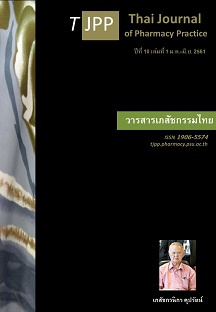ความสัมพันธ์ระหว่างความแตกฉานด้านสุขภาพกับความสามารถ ในการคุ้มครองตนเองของผู้บริโภคในเรื่องผลิตภัณฑ์สุขภาพ
Main Article Content
บทคัดย่อ
วัตถุประสงค์: เพื่อศึกษาความสัมพันธ์ระหว่างความแตกฉานด้านสุขภาพกับความสามารถของผู้บริโภคในการคุ้มครองตนเองในเรื่องผลิตภัณฑ์สุขภาพ วิธีการ: ตัวอย่าง คือ ผู้บริโภค100 คนที่เลือกมาด้วยวิธีการแบบตามสะดวกจากประชาชนในตำบลท่าซุงและตำบลน้ำซึม อำเภอเมืองอุทัยธานี จังหวัดอุทัยธานี ตัวอย่างตอบแบบสอบถามที่วัดความแตกฉานด้านสุขภาพและความสามารถในการคุ้มครองตนเองในเรื่องผลิตภัณฑ์สุขภาพ การประเมินความแตกฉานด้านสุขภาพใช้แบบวัดชนิดรายการคำที่มีคำถามทดสอบความเข้าใจ (THLA-W+) ของ ผดุง จันชูโต ส่วนแบบประเมินความสามารถในการคุ้มครองตนเองของผู้บริโภคในเรื่องผลิตภัณฑ์สุขภาพได้รับการพัฒนาขึ้นในการวิจัยนี้ ผลการวิจัย: ประชาชนร้อยละ 64 มีความสามารถในการคุ้มครองตนเองในเรื่องผลิตภัณฑ์สุขภาพอย่างเพียงพอ ความแตกฉานด้านสุขภาพมีความสัมพันธ์เชิงบวกกับความสามารถการคุ้มครองตนเองฯ อย่างมีนัยสำคัญทางสถิติ (r = 0.54, P<0.001) สรุป: การเสริมสร้างความแตกฉานด้านสุขภาพมีความสำคัญ เพราะมีแนวโน้มว่า ผู้ที่มีความแตกฉานด้านสุขภาพที่สูงกว่า จะสามารถคุ้มครองตนเองได้มากกว่าในฐานะผู้บริโภคผลิตภัณฑ์สุขภาพ
Article Details
ผลการวิจัยและความคิดเห็นที่ปรากฏในบทความถือเป็นความคิดเห็นและอยู่ในความรับผิดชอบของผู้นิพนธ์ มิใช่ความเห็นหรือความรับผิดชอบของกองบรรณาธิการ หรือคณะเภสัชศาสตร์ มหาวิทยาลัยสงขลานครินทร์ ทั้งนี้ไม่รวมความผิดพลาดอันเกิดจากการพิมพ์ บทความที่ได้รับการเผยแพร่โดยวารสารเภสัชกรรมไทยถือเป็นสิทธิ์ของวารสารฯ
เอกสารอ้างอิง
2. Sakarin W. Prevalence of microbial contamination in consumable ice at various points on supply chain from manufacturers to restaurants and food stalls. Thai Journal of Pharmacy Practice 2016; 8: 271-81.
3. Chonwihanpan W. Prevalence of inappropriate use of health products for weight control among female teenagers in Saraburi province and factors affecting it. Thai Journal of Pharmacy Practice 2016; 8: 442-55.
4. Sukamolson S, Sriviriyanuparp W, Kulsomboon V. Priority, prevalence and geographic distribution of unsafe products in Thailand. Journal of Health Systems Research 2016; 10: 65-79.
5. Bureau of Information, Office of the Permanent Secretary. FDA revealed the report on surveillance of advertising of health products in the fiscal year of 2013 with 1.9 million Baht fine and a strict continuing surveillance [online]. 2015 [cited June 25, 2017]. Available from: pr.moph.go.th/iprg/inclu de/admin_hotnew/show_hotnew.php?idHot_new=77554.
6. Sørensen K, den Broucke SV, Fullam J, Doyle G, Pelikan J, Slonska Z, et al. Health literacy and public health: A systematic review and integration of definitions and models. BMC Public Health 2012; 212: 80 doi.org/10.1186/1471-2458-12-80
7. Berkman ND, Sheridan SL, Donahue KE, Halpern DJ, Crotty K. Low health literacy and health outcomes: an updated systematic review. Ann Intern Med. 2011; 155: 97-107.
8. Cho YI, Lee SY, Arozullah AM, Crittenden KS: Effects of health literacy on health status and health service utilization amongst the elderly. Soc Sci Med 2008, 66:1809–16.
9. Evangelista LS, Rasmusson KD, Laramee AS, Barr J, Ammon SE, Dunbar S et al. Health literacy and the patient with heart failure-Implications for patient care and research: A consensus statement of the Heart Failure Society of America. J Card Fail 2010; 16: 9–16.
10. Davis TC, Wolf MS, Bass PF, III, Middlebrooks M, Kennen E, Baker DW et al. Low literacy impairs comprehension of prescription drug warning labels . J Gen Intern Med 2006; 21: 847–51.
11. Davis TC, Wolf MS, Bass PF, III, Thompson JA, Tilson HH, Neuberger M et al. Literacy and misunderstanding prescription labels. Ann Intern Med 2006; 145: 887–94.
12. Kripalani S, Henderson LE, Chiu EY, Robertson R, Koim P, Jacobson TA. Predictors of medication self-management skill in a low-literacy population. J Gen Intern 2006; 21: 852–56.
13. Faul GF, Erdfelder E, Buchner A and Lang AG. Statistical power analyses using G*Power 3.1: Tests for correlation and regression analyses. Behav Res Methods 2009; 41: 1149-60.
14. Janchooto P. Development of the Thai Health Literacy Assessment Using Word List with Extended Questions to Test Comprehension (THLA-W+) [independent study]. Songkhla: Prince of Songkla University; 2017.
15. Swets JA. Measuring the accuracy of diagnostic systems. Science 1988; 240:1285–93.


